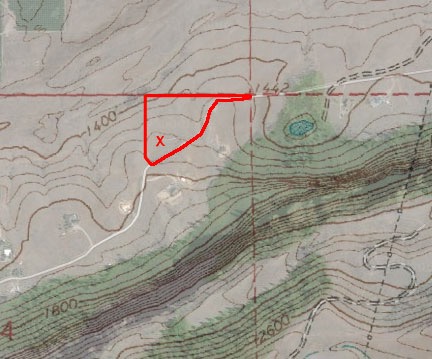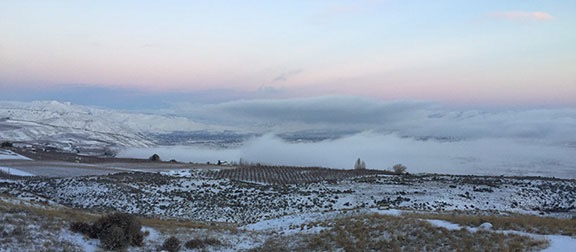The one drawback of having those magnificent basalt cliffs out behind my home is the Shadow Time.
I live on a shelf of land at the base of some 1000+ feet tall basalt cliffs. My home faces the big views to the north, toward East Wenatchee, the Columbia River, and the Wenatchee Valley. My entrance faces my driveway, which comes up from the east. Those cliffs are to the south and begin less than 1/4 mile from my home.
The cliffs are beautiful, with layers of tall basalt columns, tumbled rock making up talus slopes, and ponderosa pine trees. On summer mornings and late afternoons, the brown rock glows with warm golden hour light. Bighorn sheep jump from rock to rock up there and I can often hear the tiny landslides of rocks they set tumbling down the cliffs. Once in a while, they’ll come down as far as my neighbor’s yard to graze in his grass. I haven’t seen them across the road at my place. Yet.

Here’s a shot of the cliffs behind my home, taken last summer from my driveway. The talus slopes go almost all the way down to my neighbors’ homes on that side of the road. In fact, my neighbors’ lots actually include the cliff faces. (Not exactly usable land.)

I threw together this hybrid topo/satellite map to show the lay of the land. The odd shaped red box is my 10 acre parcel; the south property line follows the road — hence the odd shape. The X is my homesite. If you know how to read topo maps, you know that closely spaced lines indicate steep hills. In this case, the cliffs behind my home rise in two steep steps about 1,000 feet above me.
Of course, living so far north means that the angle of the sun is low during the winter months. While the whole area has long nights and short days, the folks on my road have another winter issue to contend with: living in the shadows. You see, for a period ranging from weeks (in my case) to months (in some neighbors’ cases) straddling the winter solstice, the sun does not rise high enough above the cliffs to clear them and shine on our homes.
I call this the Shadow Time.
I knew this was going to be an issue when I bought my place. It had me so concerned that in the winter of 2013, when I was still living in Arizona, I took a week-long trip up to Washington state to see for myself. It had been a very long time since I’d lived in a four-season place with a snowy winter. I wanted to experience it firsthand so I knew what I was getting into by buying here. Every day during that week, I drove the rental car — a minivan — up into the hills to look at my place. I wanted to see what the light was like. I wanted to see how much shadow there was.
That was my first exposure to January’s fog, which engulfs the valley 25% to 50% of the time — my place can be above, below, or in it. And the snowy roads. And the shadow.
But I didn’t think it was so bad. Besides, I expected to travel during the winter each year and probably wouldn’t experience it at all. So I went forward with my plans and bought the place in July 2013. I don’t regret it one damn bit.
This is my first full winter living up here. It’s hard to tell with the variable weather we get here in the winter time — it’s mostly sunny most of the year — but it seems to me that the Shadow Time starts in the first week of December and ends in the second week of January. I marked my calendar with January 15 so I could remember to pay close attention.
But as this past week whizzed by, the weather was not cooperative. There’s that January fog to contend with. Even the sunny days had some clouds to the south or southwest. It might be blazing sun down in the valley with brightness up here. Was that the sun trying to get through the clouds? Or was it still back behind the cliffs?
Yesterday dawned bright and clear, with just a few clouds scattered about. It had snowed overnight and I measured 3 inches of fresh snow on my concrete driveway apron. A low fog settled over the river; it would clear once the sun hit it.

A low fog settled over the river and Wenatchee just as the sun was rising. This was shot from the deck outside my bedroom door; my elevation is about 800 feet above the river. If you look closely, you can see my Lookout Point bench.
I went about my day, watching the shadows get shorter and shorter, seeing how the direct sunlight came closer and closer to my shelf. The insulation guys were hard at work, stuffing the space between studs with brown batting. Downstairs, in one of my garage bays, the framing guy was boxing around my plumbing so the drywall work could meet building codes for fire safety requirements. I had ribs on the Traeger and, at about 2 PM, we all took a break upstairs for lunch.
And that’s when I noticed the sun shining on my Lookout Point bench. As we ate ribs and salad and chatted about the view and construction and other things, I watched the shadow retreat to the south. Then the sun was shining through my high windows and my west side bedroom window. Outside, I could see the shadow of my building and the tall pole with its multicolored wind streamers.
The sun was back. Shadow Time was over.

I bragged to my neighbor that the sun was back and I think she was envious.
I had at least an hour of direct sun yesterday — possibly more. It didn’t start until about 2 PM and it was still full on my place at about 2:40 PM when I drove away for a doctor’s appointment. I stopped to take a photo and texted my next door neighbor, whose home is higher up but tucked back closer into the hillside. Her response an hour later showed a bit of envy.

I shot this photo from the road behind my home as I drove into town for an appointment. Those high windows really catch the winter sun.
I suspect that the Shadow Time really ended a few days ago but I couldn’t tell because of the cloudy weather. That’s okay. I’ll get more and more sun every day now — probably 15-30 minutes, depending on the sun’s arc in the sky and the shape of the cliffs it has to clear. The cliffs get lower and farther away to the southwest — that’s why I get afternoon sun first.
In about a month — or maybe sooner — I’ll start getting sun on the east side of my building as early as 10 or 11 AM. I’m hoping to have my front deck done by the time the dawn sun hits it so I can drink my coffee out there as each new day is born.
I’ll admit that I’m disappointed that I don’t get full sun all year like the folks farther north of the cliffs. But, at the same time, it was never my intention to live here year-round.
This year I have a job to do: finish my home. Next year I’ll go south, likely before Christmas or perhaps right after my annual Christmas ski trip. I’ll miss the January fog and much of the Shadow Time, returning in late February or early march to fully enjoy the orchard blooms and get my garden started.
For now, I’m just happy Shadow Time is over and look forward to more sunny winter days ahead.

 I’ve just updated my calendar of sunrise and sunset times for the Phoenix area. I’ll be keeping this up-to-date as a published calendar. Subscribe at
I’ve just updated my calendar of sunrise and sunset times for the Phoenix area. I’ll be keeping this up-to-date as a published calendar. Subscribe at  Looking at the camera today, it’s amazingly big and clunky. But it takes a decent picture — certainly good enough for my time-lapse experiments. And frankly, I was having trouble getting my mind around leaving my Nikon outdoors, unattended, for hours at a time. It could be because the tripod got knocked over once and it was sheer luck that it fell toward a rail that caught it rather than toward the empty concrete behind it. I had no love for the G5; if it broke, well, that’s the way it goes. Ditto if it got stolen. In fact, I’d be more upset about losing my tripod or
Looking at the camera today, it’s amazingly big and clunky. But it takes a decent picture — certainly good enough for my time-lapse experiments. And frankly, I was having trouble getting my mind around leaving my Nikon outdoors, unattended, for hours at a time. It could be because the tripod got knocked over once and it was sheer luck that it fell toward a rail that caught it rather than toward the empty concrete behind it. I had no love for the G5; if it broke, well, that’s the way it goes. Ditto if it got stolen. In fact, I’d be more upset about losing my tripod or